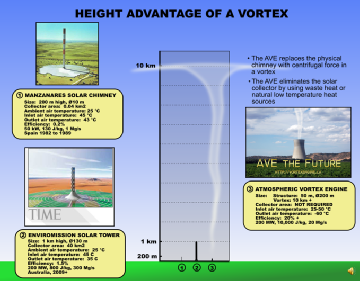WORLD ENERGY DEMAND
The demand for energy is increasing non-linear with the growth of the world population. At this time our civilisation generates about around 20 TW.
Only 0.2 TW is generated by the use of wind, photovoltaic and bio-energy.
The potential however is estimated on 8500 TW what would be more then enough to d meet human energy needs.
EARTH SOLAR ENERGY BUDGET
The earth receives 174,000 energy as soalr radiation from the sun
- Incoming solar radiation 174,000 TW
- Reflected back to space by the atmosphere or by the earth surface 52,000 TW
- Absorbed in the upper troposphere 60,000 TW
- Absorbed by the earth surface 62,000 TW
Atmosphere upward heat convection budget
- Energy carried upward by convection 62,000 TW
- Latent heat from the earth surface 41,000 TW
- Sensible heat from the earth surface 9,000 TW
- Radiation absorbed in the lower troposphere 12,000 TW
EXERGY
The atmospheric convection budget represents an energy potential because of upward air motion of atmospherical heat. The potential to produce work from temperature differences is called by various names including: available energy, ideal work and exergy - literally extractable energy.
Exergy is the maximum amount of work that can be produce when heat flows from hot to cold.
The exergy of the troposphere is approximately 14 % based on
- an average maximum temperature of +20 °C
and
- an average minimum temperature of -20 °C.
The estimated exergy of the atmosphere is therefore 14 % of the upward convection at 62,000 TW
=
8,500 TW exergy budget out of atmospheric convection.
ESTIMATED ATMOSPHERIC EXERGY BUDGET
Summarized:
- Total available energy (exergy) 8,500 TW
- Energy used to lift water 2,000 TW
- Exergy degraded in mixing processes 1,000 TW
- Exergy degraded in overcoming viscous friction in prevailing ailing winds 100 TW
- Exergy degraded by viscous friction in turbulent eddies 100 TW
- Exergy degraded as a result of heat flow by conduction or radiation 100 TW
- Exergy used to drive wind turbines 0.1 TW
- Exergy lost because there is no load to push against 5,200 TW
Irrespective of the exact values of the largest part of the exergy is degraded simply because there is nothing for it to do or push against.
In other words : it is not fully productive.
Only 0,1 TW is used to propel wind turbines.
FROM SUT TO AVE
From Solar Updraft Tower (SUT) to Atmospheric Vortex Engine (AVE).
The Manzanares solar chimney demonstrated that upward heat flow in the atmosphere can produce power. A turbine located in the base of the 200 m high by 10 m diameter chimney produced 50 kW of electricity. Friction and exit losses were approximately 25 kW.
Ambient air was heated by 20 °C in a 250 m diameter greenhouse located around the base of the chimney. The exergy is captured by forcing the expansion to take place in a chimney and restricting the flow with a turbine located in the base of the chimney.
The chimney prevents the warm rising air from being diluted by cooler ambient air and transfers the work of expansion to the turbine.
REPLACING THE CHIMNEY AN INCREASING EFFICIENCY
The ideal efficiency of a solar chimney is equal to the difference in ambient temperature at the base and top of the chimney divided by base ambient temperature. Solar chimney efficiency is proportional to chimney height.
Natural vortices such as tornadoes produce intense mechanical energy because a convective vortex acts like virtual chimneys. Centrifugal force in the vortex prevents horizontal convergence and transfer the work of expansion downward.
Learning to produce and control tornado like vortices could permit the production of clean carbon free energy in quantities far exceeding current human needs.
Developing the AVE will require a concerted development effort. Humans could surely learn to control a natural occurring process thereby meeting their energy needs. Mother Nature does it without any help from us why can’t we?
REFERENCES
Michaud, L. 2017: The Atmospheric Exergy Budget or ‘Almost unlimmited clean energy’
Brunhes, B., 1909: La degradation de l’énergie. Flammiron, France, 410 pages.
Marquet, P., 1996: L’énergie utilisable dans l’atmosphère. Histoire et développements
récents. La Météorologie, No. 14, juin, 1996.
Trenberth, K. E., Fasullo, J. T., Kiehl, J., 2009: Earth’s global energy budget. Bull. Amer.
Meteor. Soc., 90-3, 311-323, DOI:10.1175/2008BAMS2634.1.












